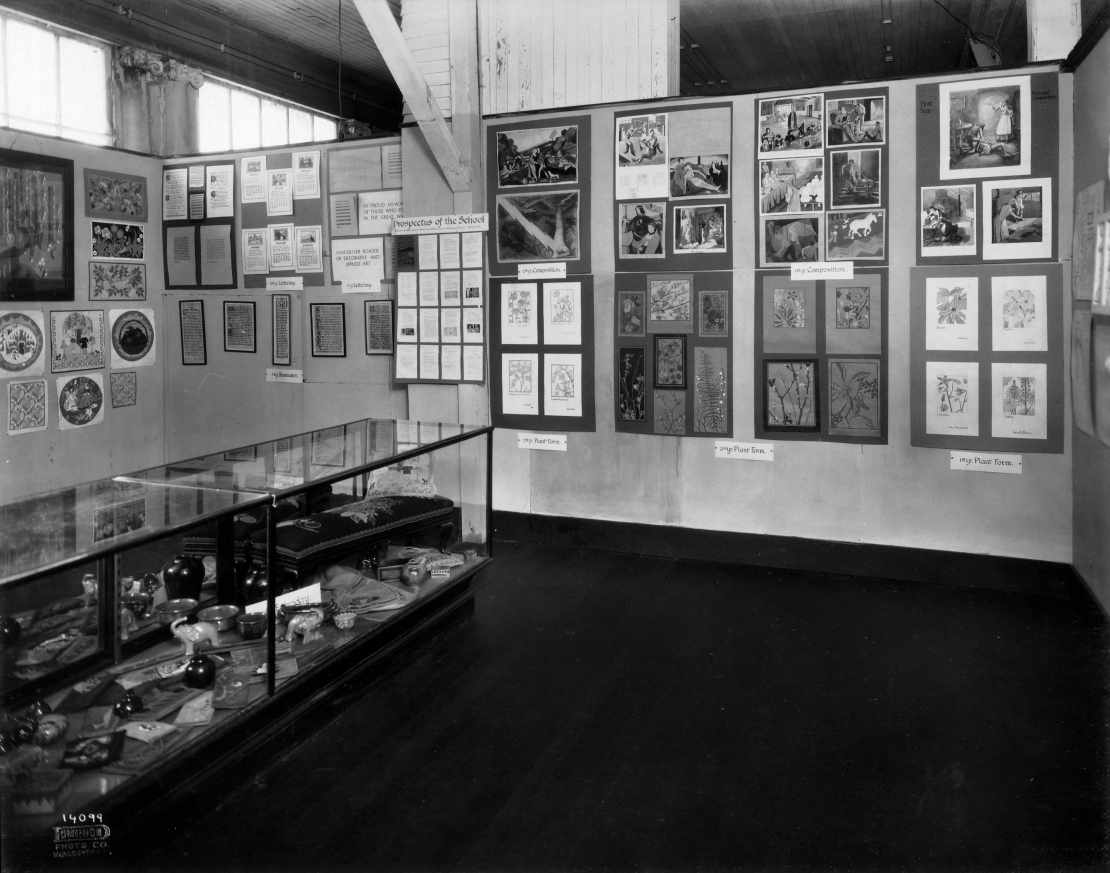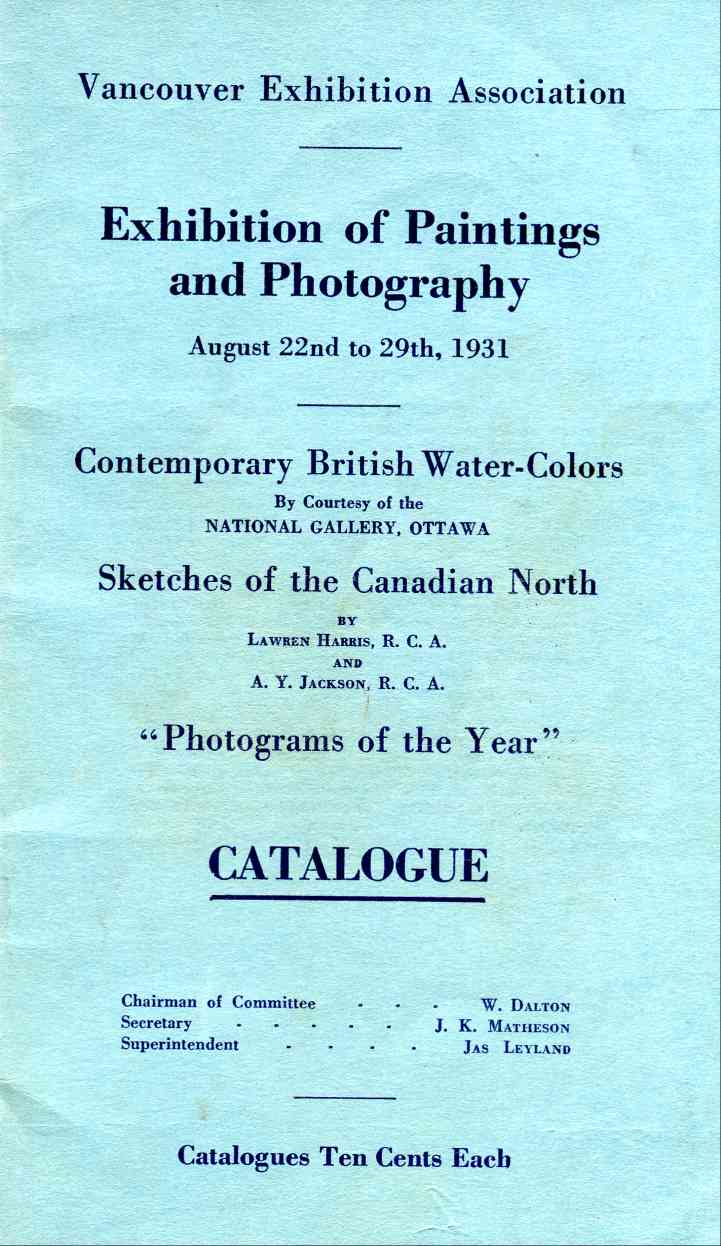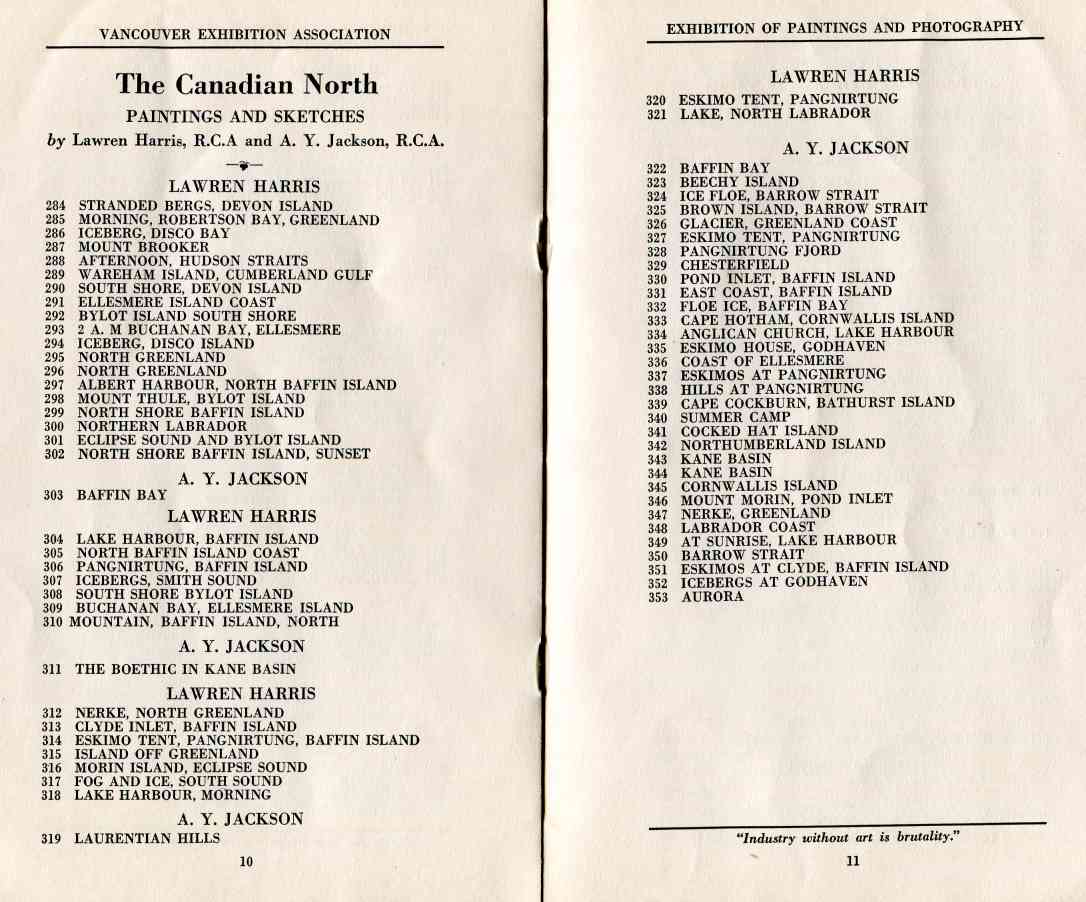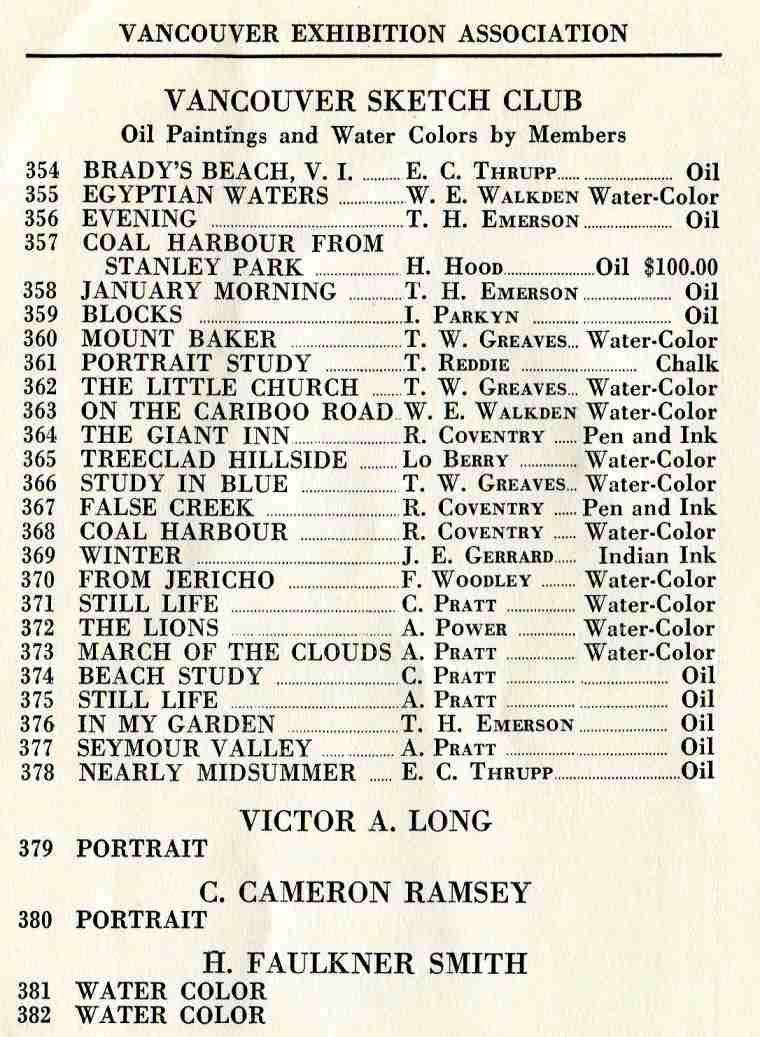
1928 art school display at P.N.E.
| BRITISH COLUMBIA ARTISTS |
The site chosen for the exhibition had first been created as a country race track in 1888, when it was reached from Vancouver by steamer from the foot of Carroll Street, or by walking from the street car line that stopped at Victoria Drive. The grounds were secured in 1908 over the opposition of the local horse racing community who used the rough racetrack carved out of the forest, and construction commenced. It was an immediate success when it opened on August 15, 1910, and had an attendance of 68,000 people the first year. Access to the exhibition slowly improved with the extension of streetcar lines and roads.
The fair was formally known as the Vancouver Exhibition (as separate from the New Westminster exhibition), but was often referred to as the Hastings Exhibition because of its location. It was advertised as the Greater Vancouver Exhibition, and as the Canada Pacific Exhibition. In 1946 the name was formally changed to the Pacific National Exhibition, and Hastings Park was renamed Exhibition Park at that time.
The original Constitution of the exhibition included as one of its objects "The
encouragement of the cultivation of the beautiful in nature and art."
From its beginning the Exhibition included displays of art and handicrafts, thus
becoming one of the first places in the Lower Mainland that artists could display their
work in public. Conditions for displaying artwork were quite primitive at the beginning,
though, and the visitor would encounter quite a mix of displays, as noted in a review
of the first exhibition in the Vancouver Daily News-Advertiser, on August 16 1910:
"Leaving the main floor, and going by way of the northeast set of stairs to the gallery,
the visitor, on alighting on the upper portion of the building is struck by the magnificent
display of the Local Council of Women. Fancy work of all kinds, tapestries, embroideries,
doilies, sofa cushions, baby goods and such, tastefully arranged in show cases and along
counters, tend to make the display of the women one of the best in the Exhibition.
Proceeding around the gallery the visitor sees the art exhibit with its fine assortment
of paintings, oil and watercolors by local artists. At the end of the building a showcase
filled with mounted birds is shown by a local taxidermist, while more pictures and a
display of ores finish up the sights in this end."
Ten years later the struggle for good gallery conditions continued, as noted in the
June 5, 1920 column "Art At The Vancouver Exhibition" in the
Western Woman's Weekly:
"It is hoped that by this union of Art Societies with the Exhibition Association, the Fine
Art Building at Hastings Park will this year offer an exhibition of pictures which shall
be worthy of the city.
Local artists who have hitherto refrained from exhibiting at Hastings Park owing to the
faulty building and the indiscriminate hanging of works need refrain no longer. The
Advisory Board of Fine Arts and the Exhibition Association are determined to put on
an exhibition which shall be of aesthetic value."

Fears that the opening of the exhibition would spell the end of the existing exhibition in New Westminster proved unfounded, and a strengthened fair circuit resulted, including Victoria on the island, with increased entries and exhibits. The New Westminster exhibition eventually merged into the Vancouver Exhibition around 1930 after the New Westminster fair grounds and buildings burned down.



The fair grounds were pressed into use during both world wars. In World War I, troops were marshalled on the parade grounds before shipping off overseas. In World War II, the Japanese living on the West Coast were held there pending relocation to internment camps.
| DATE | TITLE |
| August 1910 | First Exhibition |
| August 1922 | Group of Seven Exhibition |
| August 9 - 16 1924 | Exhibition of Oil Paintings, Water Colors and Etchings |
| August 1925 | Exhibition of Oil Paintings, Water Colors and Etchings |
| August 1926 | Fine Arts Exhibits |
| August 10 - 20 1927 | Exhibition of Oil Paintings, Water Colors and Etchings, including a Collection of Water Colours by Charles John Collings. |
| August 6 - 16 1930 | Exhibitions of Oil Paintings and Water-Colours Loaned by Citizens, and Paintings Loaned by Members of The B.C. Society of Fine Arts, The Palette and Chisel Club, The Vancouver Sketch Club, The Island Arts and Crafts, Victoria. |
| August 22- 29 1931 | Exhibition of Paintings and Photography, including Contemporary British Water-Colors; Sketches of the Canadian North by Lawren Harris, R.C.A. and A.Y. Jackson, R.C.A.; Photograms of the Year. |
| Aug. 29 - Sept. 5 1932 | Exhibition of Painting and Photography, including Contemporary British Paintings; Photograms of the Year; The Vancouver Sketch Club exhibit. |
The Pacific National Exhibition - An Illustrated History
David Breen and Kenneth Coates
1982, U.B.C. Press, ISBN 0-7748-0167-0, 122 pages, illustrated
Vancouver's Fair - An Administrative & Political History of the The Pacific
National Exhibition
David Breen and Kenneth Coates
1982, U.B.C. Press, ISBN 0-7748-0161-1, 192 pages, illustrated
Includes index; notes; statistics; bibliography
THE GROUP OF SEVEN - ART FOR A NATION
1995, Charles C. Hill, National Gallery of Canada, ISBN 0-7710-6716-x
Includes exhibition list, with G7 shows in Western Canada
"Art Gallery At Exhibition Great Attraction This Year" by J.L.
Western Woman's Weekly, July 29 1922
"An innovation will be introduced to the Vancouver Exhibition Association
this year in connection with a fine arts exhibit. This will consist in the catering exclusively
to British Columbia artists and collectors. In former years the exhibition has received the loan
of picture from the national gallery at Ottawa and made a bid for collections from outside
the province. This year attention will be paid entirely to British Columbia water colors and
oils, perticularly to water colours." (continues)
From "Will Feature B.C. Artists"
Vancouver Province, May 10 1924
"THE VANCOUVER EXHIBITION:
Two loan collections were made to the annual Fair, one in the Art Section,
and the other to the Native Sons of B.C., who made an attractive display of native
Indian art, in a model of a typical Hudson's Bay Co.'s fort, that at Fort St. James,
about 1850, being selected, and which proved to be a great success."
From "Curator's Report" by T.P.O. Menzies
Museum Notes, Vol. 1, No. 1, February 1926
"So far no Art Gallery had come into being in the Province and exhibitions of Art
from the outside were restricted to occasional showings brought from the East by
the Exhibition Association, to Hastings Park, where they took their place
uncomfortably with the livestock, the manufactures, the products of the field and
garden, and the skidroad."
From "A Short Art History of British Columbia" by
Charles H. Scott
Behind The Palette, June 1947
"Magic of Hard Work Makes PNE Attractive" by A.J. Dalrymple, Agricultural Editor
Vancouver Province, August 18 1947